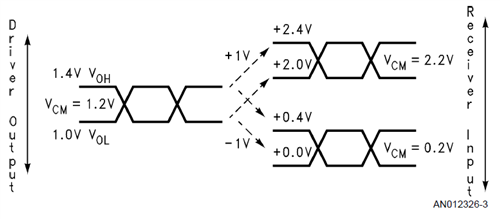Other Parts Discussed in Thread: DS90CR482
Hi team,
The customer would like to use DS90CR288A. The DS90CR288A datasheet shows the Receiver Input Range Voltage is 0~2.4V
and the Differential Input High Threshold is -100mV~100mV. For the 0~2.4V input voltage, my understanding is
the common voltage range of the RxINx+ pin or the the RxINx- pin. And the 0~2.4V input voltage can meet the TIA/EIA-644 LVDS Standard.
Q1. Is my understanding correct?
Q2. The customer said there were 2.5VLVDS standard, 3.3VLVDS standard and 5VLVDS standard. I think 2.5V, 3.3V or 5V is
indicated the VCC voltage. Is this correct? Would you explain the 2.5VLVDS standard, 3.3VLVDS standard and 5VLVDS standard?
Q3. The customer's input common voltage is 2.5V. It is above 2.4V. So DS90CR288A cannot meet his requirement.
So he needs to verify if we have the similar device that can meet the 2.5V input common voltage.
If my above understanding is correct, this mean we do not have the device which can meet the customer's input common voltage.
Would you help me to verify this?
Q4. However, I note DS90CR482. The Absolute Maximum Ratings shows the e Receiver Input Range Voltage is -0.3V~3.6V.
Can DS90CR482 meet the customer's requirement that the input common voltage is 2.5V?
Best Wishes,
Mickey Zhang
Asia Customer Support Center
Texas Instruments


